Rattlesnakes
Almost everyone is fascinated by rattlesnakes. The fascination is most often caused by fear of these animals, which are legendarily perceived to be aggressive and deadly. Although their threat to humans is grossly exaggerated, these snakes are fascinating for another compelling reason: rattlesnakes are among the most highly specialized organisms on the planet.
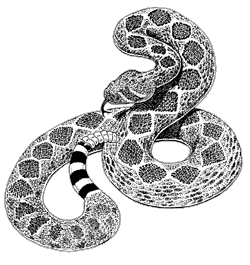 |
Their venom—in fact a toxic saliva—is among the most complex substances known: a mixture of enzymes unique to pit vipers that destroys blood or paralyzes nerves. And the delivery system is equally amazing—the snakes’ fangs are movable hypodermic syringes. Rattlesnakes are also among the few animal groups with dual visual systems. In addition to their eyes, they have sensory organs in their upper jaws which can actually “see”infrared images. They can detect the heat from a candle flame 30 feet (9 m) away. These animals merit admiration more than fear.
While other areas have larger rattlesnakes, the Sonoran Desert region is blessed (no, that isn’t a misprint) with more species of rattlesnakes than is any other region in the world—and many of them will bite large beasts like us if we are perceived to be a threat. Rather than seeking to eradicate these animals, we have more to gain by finding ways for all of us to coexist. Why? Because these animals are the natural predators of a suite of other animals (e.g., mice and rats) that can cause plant damage, carry diseases, and so on. Besides, trying to kill rattlesnakes actually puts us at greater risk than does leaving them alone.
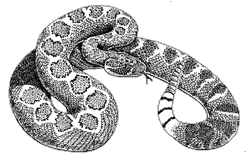 |
Knowledge of “who” these creatures are—that is, what they do for a living, where they live and when they are active—will help us coexist without harm to either snakes or humans.
Most rattlesnakes avoid contact with humans. They tend to avoid wide open spaces that offer little protection from predators, so they usually spend their time in and under low-growing shrubs, natural and artificial debris, rocks and the like.
They are most active in the warmer times of the year—spring through early fall—and many of them are nocturnal during the summer months. When favorable temperatures occur, many rattlesnakes are marginally active even during the winter. You are most likely to see them when the air temperature is between 70° and 90°F (21° to 32°C), regardless of the time of day—be it June or January.
Venom
Rattlesnakes may be among nature’s best examples of efficiency and econ-omy of motion. The use of venom to capture prey conserves considerable energy that would otherwise be needed to capture and subdue an animal.
Rattlesnakes have very long, curved fangs that lie parallel to the jaw line when not in use. When rattlesnakes strike, the fangs are rotated by muscular contraction to an erect position, somewhat perpendicular to the jaw line. The fangs are hollow, which allows the snake to inject venom through the tooth into its victim. Each fang is connected to a venom gland (located toward the back of the head on the upper side) by a venom duct. Baby rattlesnakes (born live from mid-summer to early autumn) arrive fully equipped with teeth and toxins!
Rattlesnake venom functions primarily to help the animals feed, facilitating capture and partial digestion of prey. It is not believed to have originated as a defensive weapon to avoid predation or molestation (though it can be very effective in this regard).
Approximately 20 percent of defensive strikes are “dry;” that is, no venom is injected. This has led to the common belief that rattlesnakes can “choose” not to envenomate, although it is unknown why rattlesnakes elect to control venom injection in this defensive context.
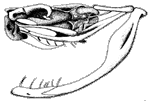 |  |
Snake venoms are extremely complex; there is no “standard” rattlesnake venom. They consist of combinations of proteins that range from hemotoxins, which break down cells and tissues, to anticoagulants and neurotoxins that may cause circulatory arrest or respiratory paralysis.
Heat Vision
Rattlesnakes and other pit vipers have remarkable heat-sensing pits. Located behind each nostril, below a straight line that would directly connect the nostril to the eye, is a loreal pit (called this because it is a depression in the loreal scale). These pits are highly effective in detecting differences in temperature even several yards away. At short ranges within a foot or so, minute differences (of perhaps fractions of a degree) may be perceived.
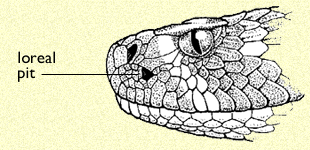
Heat given off by an animal creates a heat image; therefore, rattlesnakes have “heat vision.” The heat images are integrated with visual ones in the brain. This type of vision is helpful for nocturnal predators, for it enables them to hunt effectively even in total darkness. It may also help distinguish predator from prey, allowing rattlesnakes to determine whether they are at risk themselves. Larger, non-prey animals give off larger heat images, signaling the snakes to avoid potential encounters with these animals.
If It Rattles . . .
The best way to distinguish rattlesnakes from other kinds of snakes is by the rattle. Most other characteristics are either too subjective or inconsistent, or else they require one to get too close to the animal for safety. Even at birth, rattlesnakes have the first segment of a rattle, which is called a “prebutton.”The prebutton is lost the first time the snake sheds its skin and is replaced by a button. Each shedding episode that follows adds another segment to the rattle, and rattlesnakes may shed one to four or more times each year. Only when there is more than one segment can the rattle produce sound. There isn’t anything inside the rattle; the various segments merely bump against each other to produce the sound. The tremendous amount of sound produced results from movement of the rattle back and forth 60 or more times per second!
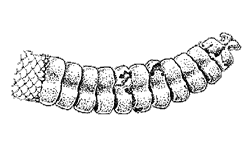
The rattle is composed of fibrous protein called keratin—as are your fingernails—and segments can easily break off. Because segments are added at various rates, and because they break off, it is not possible to tell a snake’s age by counting the segments.
In addition to the change in structure from small scales to large rattle segments, rattlesnake tails look stumpy, almost as though their tips had been snipped off. Other snakes have tails that come to smooth tapering points, much like pencil points.
Click to hear Western Diamondback sounds
Motherly Love
Few reptiles exhibit parental care of their young. However, there are notable exceptions —mother American alligators may watch over their young for periods of up to four years. Without evidence to the contrary, scientists take a conservative approach and assume that parental care is absent in most reptiles.
Sometimes scientists may make premature judgments based on incomplete information. For years it was assumed that rattlesnakes do not care for their young after birth. Yet, Dr. Harry Greene of the University of California, Berkeley, has found that female black-tailed rattlesnakes stay with their young until they complete their first shed, about a week’s time. Similar observations have been made by herpetologist Hugh McCrystal with other species of rattlesnakes such as the rock rattlesnake. In the future, we may find that most rattlesnake species exhibit parental care.










